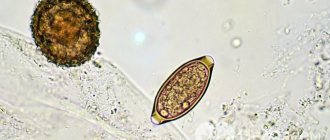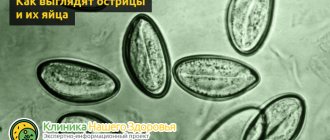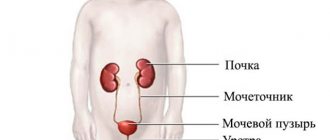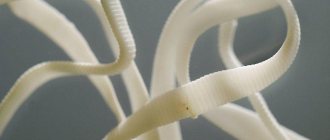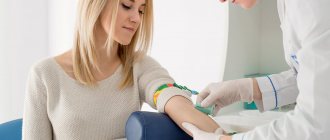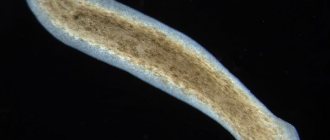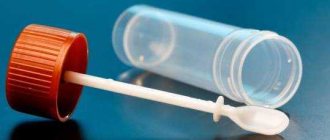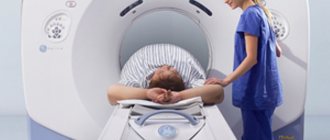Diagnosis of enterobiasis, like any other parasitic disease, is an important link in the treatment process and the sooner the correct diagnosis is established, the more effective the subsequent stage of recovery from invasion will be.
The most reliable modern diagnostic method for identifying parasites (pinworms) is scraping for enterobiasis, as a result of which the presence or absence of helminth eggs is determined.
How to take scrapings from a child at home
In some situations, it is not possible to take the child to a medical facility to have a scraping taken for enterobiasis.
In this situation, it is allowed to independently collect biomaterial at home and then submit it to the laboratory for research. In this case, you should follow the same rules as when preparing for a scraping performed in a clinic. At home, it is most convenient to collect material for research using a special container and a glass slide with adhesive tape.
This container is designed specifically for scraping.
It is necessary to put on disposable gloves, place the child on his side, spread his buttocks with one hand, and with the other take the material, running the applicator over the skin around the anus several times, trying to touch different areas.
Then the instrument must be carefully placed in a container, closed and delivered to a medical facility as quickly as possible. The material can be stored for no more than 2 hours and only at a temperature not higher than 8°C.
The material can be stored for no more than 2 hours and only at a temperature not higher than 8°C.
When using a glass slide with adhesive tape, the following algorithm for taking material must be observed:
- Wash your hands with soap and wear gloves.
- Place the child on his side or tilt him forward.
- Remove the tape from the glass, being careful not to touch the surface of the instrument or the sticky layer of the tape.
- Spread the child's buttocks with one hand without touching the anus.
- With your other hand, firmly apply the tape to the anus for a few seconds.
- Remove the strip from the skin and glue it onto a glass slide.
- Send the material to the bacteriological laboratory.
Before the procedure, you need to wash your hands.
To take a smear, you need to remove the tape from the glass, being careful not to touch the surface of the instrument and the sticky layer of the tape.
After taking a smear, you need to send the material to a bacteriological laboratory.
Parasites do not lay eggs every night. If the child slept peacefully at night, then there is a possibility that pinworms did not torment him and their eggs will not be detected in the analysis. In this case, it is better to postpone the procedure. Scraping of a child is carried out using the methods described above.
It is better to pick up a small child, spread the buttocks, and pass a cotton swab around the anus. It is difficult to use a spatula on children. You can explain to teenagers the essence of the manipulations, how to take scrapings correctly, they will do everything themselves.
The test must be taken by all children of any age, as it is a common medical test for identifying helminthic infestations and is cheap, unlike other types of tests.
Analysis required:
- To control the treatment of helminthic infestations.
- For registration at a sanatorium-resort institution for treatment.
- To obtain a certificate for the swimming pool.
- For the planned admission of a child to a hospital for treatment or research.
- To enroll a child in a preschool or educational institution.
- Suspicion of enterobiasis.
Signs indicating enterobiasis in a child:
- itching and burning in the anus;
- the presence of pinworms on the child’s underwear or in the anus;
- abdominal pain accompanied by indigestion;
- redness of the skin in the perineal area and scratching;
- the child often puts his hands into his underpants and touches his genitals.
This diagnostic method involves collecting material for examination, usually performed by a health worker in a laboratory or a special collection room. There are 2 ways to collect material.
Method I – using cotton swabs:
- Put on gloves and open the test tube.
- The child is tilted and spreads the buttocks with the thumb and index fingers of the left hand.
- A cotton swab is used to collect material using circular movements around the anus.
- Place a cotton swab in the test tube and close the lid tightly.
- The signed tube is sent to the laboratory no later than 8 hours after the material is taken.
Method II - using adhesive tape:
- You need a special adhesive tape, which is used to collect the analysis.
- Put on gloves and peel off the tape from the glass.
- The child is tilted and spreads the buttocks with the thumb and index fingers of the left hand.
- A special tape is pressed tightly to the anus.
- The tape is returned to the glass and the test material is taken to the laboratory within 8 hours.
Scraping for enterobiasis is done in the following cases:
- Suspicion of pinworm infection.
- Before the child arrives at school or kindergarten.
- Help for the pool.
- Registration of a voucher to a camp or sanatorium.
To ensure accurate results, you need to prepare before taking the test:
- Do not take strong medications (especially antibiotics).
- The day before the test, do not eat fried or fatty foods.
- On the day of delivery of the material, you cannot wash your child before the smear.
The doctor issues a referral for analysis. In the laboratory, after explaining the course of the future procedure, the child is placed on his side. The nurse spreads the buttocks and scrapes the anus and its folds with a glycerin-soaked swab or cotton swab. Then the material is placed in a test tube, the name is written down and sent to the laboratory.
The execution algorithm is very similar to the previous one. The difference is that instead of a cotton swab, adhesive tape is used. When performing the analysis, the tape is glued to the folds around the outlet for a couple of seconds. After removal, it is glued onto a glass slide. The material is then sent to the laboratory, where a laboratory technician examines it under a microscope for the presence of parasite eggs.
Eyesticks are glass spatulas with one flared edge. During analysis, the extended end of the stick is immersed in special glue and allowed to dry a little. After drying, a film is formed, the stick is applied to the anus and folds around it. Then the spatula is placed in a special test tube and taken for examination.
Subungual scraping
Worm eggs can be detected during examination using subungual scraping in kindergarten. The nurse scrapes under the child's fingernail with a wooden stick. Pinworm eggs spread very quickly. If a child sick with enterobiasis goes to kindergarten, then there is a chance that the entire group will become infected. The remaining children also need to be examined. If the examination shows more than 15% infection, then all children are sent for treatment.
Most often, analysis is carried out using adhesive tape and a cotton swab.
The validity period of a smear for enterobiasis is 10 days.
After treatment of this disease or if there is uncertainty in the previous analysis, an additional scraping is performed.
If symptoms persist and the test is negative for pinworms, the test is done at least three times. For a complete examination, a blood test is prescribed for the presence of parasites. If the child does not have symptoms of worm infection, and the only question is how to submit the scraping to kindergarten, then one test is enough.
When treating enterebiosis in children, medications and folk remedies are used.
For children of any age, such laboratory research is always psychological trauma and internal fear of the unknown. However, adults should clearly understand how important it is to perform the test correctly and not get a false positive result. Therefore, it is necessary to mentally prepare the little patient in advance so that he is not afraid and relaxes.
So, if an analysis is taken for enterobiasis in children, the first thing the child needs to do is lower his clothes and underwear and relax his buttocks. To alleviate such an unpleasant moment, the doctor can use glycerin. Afterwards, all he has to do is collect the material from the surface of the anus and place it in a special container with a sticker for further examination under a microscope.
A flush for enterobiasis must be performed if the patient has an itchy perineum, allergic reactions occur, and intestinal dysfunction with a sharp loosening of stools is observed. Since eggworms do not pass into the feces, the anus must be examined for examination. If it is necessary for a child to be tested for enterobiasis, the sequence of actions is as follows:
- Relax your buttocks, as the scraping is not painful at all.
- Moisten a cotton swab with saline solution and glycerin.
- Using the rod, treat the anus and folds of the anus.
- Place it in a special container and seal it tightly for further research.
At home, these manipulations are carried out according to the same principle. In order for laboratory testing for enterobiasis to be performed correctly, it is necessary to prepare a sterile container, adhesive tape and glass in advance. To further conduct the in vitro test, the following sequence of actions is required on the part of adult parents:
- Before taking a scraping from a child, do not wash, perform the procedure in the morning - immediately after waking up.
- Take the scraping as described above, then dip the cotton swab into a sterile container and close it tightly.
- Store biological material after scraping in the refrigerator, but in order to determine the result correctly, do not hesitate to visit the laboratory.
If material is taken for scraping for enterobiasis from the older generation, the doctor will act on the same principle. But instead of adhesive tape, it’s definitely a cotton swab or swab. To get a smear for enterobiasis in adults, the doctor writes out a referral and then explains all the intricacies of a typical laboratory test.
- The patient takes a horizontal position, and the nurse puts on sterile gloves.
- Using a cotton swab, a scraping is performed, examining the folds of the anus.
- Closes the sterile container with a lid, and then sends it to laboratory assistants for further diagnosis.
The main symptoms of helminthic infestation
Parents need to be very vigilant if the child has complaints of diffuse abdominal pain, nausea and vomiting, increased salivation, allergic manifestations on the skin, itching in the external genitalia and folds around the anus, frequent urinary tract infections, recurrent synechiae in girls , masturbation or enuresis. Some patients experience persistent changes in the general blood test: an increase in the level of eosinophils, a decrease in hemoglobin (normocytic or microcytic anemia).
Indirect symptoms of helminthiasis can be irritability and fatigue, bruises around the eyes, sleep disturbances (screams at night, crying for no reason, frequent waking up), headache, weight loss, frequent ARVI.
Since these symptoms are only indirect signs of enterobiasis infection, special methods that allow confirming the diagnosis play an important role in diagnosis. These include the following analysis options:
- 1Scraping from the perianal folds, performed in several ways.
- 2Fecal microscopy (standard stool analysis for oviworm).
- 3Detection of pinworm DNA in feces using PCR.
Scraping from the perianal folds can be performed in the following modifications:
- 1Classical scraping for enterobiasis (Torgushin method or Kevorkova method);
- 2Print on transparent adhesive tape from the perianal area using the Graham method;
- 3An alternative option is to make an imprint on a sticky transparent blade, with its further microscopic examination (the so-called Rabinovich method).
Indications for analysis
The study of biomaterial from a patient with suspected helminthiasis occurs in several ways. Biomaterial for laboratory tests is taken from the anus, or in the case of a blood test, from the patient’s vein. For a child, a scraping is most often prescribed. The helminthoovoscopy method is based on the detection of pinworm eggs in the eyepiece of a microscope.
A direct indication for a child to undergo testing is pronounced symptoms of a parasitic disease. At the initial examination, the doctor interviews the parents of the little patient and, based on the clinical picture of the disease, the specialist prescribes tests and studies. What should parents of a sick child be wary of?
Such an examination is carried out when certain symptoms appear, also for preventive purposes.
Indications for scraping:
- signs of helminthiasis (severe burning near the anus, especially at night, weight loss, migraine, deterioration of attention, memory, severe fatigue, irritability, nausea, allergic manifestations);
- prescribed to patients when sent to hospital for treatment;
- when undergoing medical examination;
- children and adults when going for health, for example to a sanatorium;
- to obtain a certificate of the absence of parasites for visiting public institutions, for example, for children to register for children's institutions, clubs, centers, for classes in the pool.
The absence of parasites is determined when issuing a health certificate.
A referral for testing is given by a local pediatrician or nurse. Sometimes a specialist, for example a gastroenterologist, can refer you for analysis if there is a suspicion of pinworm infection.
Indications for examination for eggworm:
- for permission to visit the pool;
- for registration of a sanatorium book;
- upon planned admission to the hospital;
- when passing a medical examination in a kindergarten, camp, school;
- checking the effectiveness of the prescribed treatment;
- in the presence of signs of enterobiasis.
If the first points have a preventive value, then the last two are aimed at curing a possible infection. Symptoms of the disease are:
- itching and burning in the anus, especially at night (in girls it can spread to the genitals);
- scratching of egg-laying sites, inflammatory processes on the skin;
- weight loss while appetite remains the same;
- bloating, diarrhea, or constipation;
- nausea and vomiting;
- irritability, anxiety, sleep disturbances;
- deterioration of hair and skin condition;
- allergic manifestations, mainly on the skin (atopic dermatitis, urticaria);
- stomach ache;
- enuresis;
- in case of severe damage, fainting, fever, appendicitis.
Parents should closely monitor the state of their children's health, and if their children show signs of infection with worms, get tested. This is especially true for babies under one year old who cannot describe their feelings and disturbing symptoms.
Despite the fact that the life cycle of the parasite is only a month, due to repeated infection, children can be sick for a long time. Symptoms in children are more pronounced than in adults, but they are blurred. Sometimes the symptoms coincide with another disease, making them even more difficult to recognize.
Severe symptoms of parasitosis appear with significant intoxication with waste products of helminths. That is why infection is often discovered by chance during a preventive examination. It is important to take the tests prescribed by the pediatrician on time and follow the established rules for collecting material.
Adults, due to blurred signs of infection, can pose a hidden danger, so they are also regularly checked for enterobiasis. The analysis is especially relevant for those who constantly work with children (caregivers, teachers), medical workers and cooks.
An alternative to scraping for enterobiasis can be a PCR test, but it costs much more. Parents can conduct it at their own expense in a paid laboratory; state clinics do not provide such a service. More informative is a stool test for the presence of worm eggs; to carry it out, you need to ask for a referral from your pediatrician. It is more difficult to correctly test feces for enterobiasis; you need to follow some rules, otherwise the result will be incorrect.
What is enterobiasis
Enterobiasis is a common disease, since you have to deal with it quite often throughout your life. This is the name given to the disease that occurs as a result of the reproduction process of these parasites. Preschool children are more susceptible to infection. But since the main route of infection is through household contact, parents whose children are diagnosed with enterobiasis are also often exposed to this disease.
The occurrence of enterobiasis is provoked by pinworms. These parasitic worms reach a size of no more than 10 millimeters. It is the pointed tip that gives pinworms their name. Parasites are observed in different colors: from white and yellow to black and dark brown. This disease is also called “dirty hand disease”, since infection most often occurs in this way.
The pathogenesis of enterobiasis is as follows:
- pinworm eggs enter the human body through the respiratory tract or mouth;
- after about two weeks, the larvae transform into adults capable of reproduction in the intestines;
- parasites are localized in the areas of the small and large intestines;
- At night, female worms emerge from the anus to lay eggs. When laying, parasites secrete a liquid that causes itching, irritation and redness of the skin;
- After laying eggs, female pinworms die.
An infected child or adult may find the night of laying particularly uncomfortable. In the morning, a person feels severe itching, which provokes him to scratch the anus. Thus, repeated self-infection most often occurs in children who have the habit of biting their nails or licking their fingers.
be careful
According to statistics, more than 1 billion people are infected with parasites. You may not even realize that you have become a victim of parasites.
It is easy to determine the presence of parasites in the body by one symptom - bad breath. Ask your loved ones if your breath smells in the morning (before you brush your teeth). If yes, then with a 99% probability you are infected with parasites.
In men, parasites cause: prostatitis, impotence, adenoma, cystitis, sand, kidney and bladder stones.
In women: pain and inflammation of the ovaries. Fibroma, myoma, fibrocystic mastopathy, inflammation of the adrenal glands, bladder and kidneys develop. As well as heart disease and cancer.
We would like to warn you right away that you do not need to run to the pharmacy and buy expensive medications, which, according to pharmacists, will eradicate all parasites. Most medications are extremely ineffective, and they also cause great harm to the body.
Preparation for analysis for enterobiasis
There is no special preparation for the analysis; there are general recommendations that will help to obtain a reliable analysis result.
Recommendations:
- stop taking medications a week before;
- purchase a special tube for collecting scrapings or a container for feces;
- if a scraping is taken, then there is no need to wash the child;
- scraping should not be done after defecation;
- It is recommended to collect feces from several areas.
By following simple recommendations, you can diagnose enterobiasis with high accuracy.
Where can I get tested for enterobiasis?
Submit the test material to any laboratory in the city where this type of research is carried out.
More often, children undergo tests at a children's clinic based on their registration.
Scraping for pinworm eggs:
- Negative. Test results indicate the absence of helminths on the skin. Which does not indicate their presence in the body. Therefore, it is recommended to test for enterobiasis several times.
- Positive. A positive test result indicates the presence of helminths and does not exclude the presence of other types of parasites.
The analysis is carried out as follows:
- The child is seated on the potty and asked to empty his bladder.
- Then drain, rinse and wipe the pot dry.
- The child is placed on the potty, he empties the gastrointestinal tract.
- You can then collect stool from several areas and place them in a container.
- Sign the jar and you must submit it to the laboratory along with the referral.
- On the appointed day, the laboratory assistant will come and collect the test results.
Typically, the analysis is completed in a few minutes, so results can be obtained the next day.
You can donate scrapings for pinworm eggs:
- children's Hospital;
- hospital laboratory;
- private laboratories;
- clinics;
- medical centers.
Scraping for enterobiasis in children in the clinic is carried out on the direction of a doctor. No special preparation is required for the test, but parents need to remember that the child should not be washed before the test. In addition, you cannot donate biomaterial after defecation, as this may affect the diagnostic result. It is best to come to the clinic early in the morning, when the baby has just woken up.
Then she slightly spreads the patient’s buttocks without touching the anus, and using adhesive tape, a special spatula with an adhesive layer, an applicator with a cotton tip or a swab dipped in an aqueous or glycerin solution, takes the material, touching the device several times to different places in the perianal area .
The resulting material is placed on a glass slide or in a sterile container, which is then sent to the laboratory.
The test procedure itself is completely safe and painless for the child and takes no more than 1 minute.
The test procedure itself takes no more than 1 minute.
You can carry out the scraping at the district clinic, but first make sure that there is a laboratory on its territory. If it is not there, it’s time to go to the hospital at the place of registration, where they will definitely take the specified material for further research. It is possible that the scraping will be carried out on the spot, and the patient will spend a few minutes of his time.
To undergo a scraping test for enterobiasis, you can go to a private clinic or medical center. The procedure is inexpensive, available to everyone, and does not require a medical referral from the attending physician. After receiving the result, it must be provided for its intended purpose, for example, upon admission to kindergarten, school or inpatient treatment. Certain types of fitness and more require such analysis.
Parents choose where to get their child tested for enterobiasis. Pinworms and roundworms do not directly threaten the life of a small patient. Guided by concern for the baby’s mental state, the doctor allows parents to take scrapings at home, but only after completing all stages of the procedure. In the laboratory, scraping is taken much faster and with better quality.
Enterobiasis is one of the most common parasitic diseases among children. Unwashed hands are the main source of helminth eggs. Getting rid of pinworms, especially in the early stages of the disease, will not be difficult; the main thing is to detect the parasite in a timely manner, and for this you should undergo mandatory laboratory tests - blood, feces, scrapings from the perianal folds.
What is the reason for such a diagnostic search?
Laboratory research is based on the development cycle of the helminth. All processes of maturation and fertilization of the parasite occur in the distal part of the small intestine, after which females with mature eggs descend into the rectum. Actively crawling out of the anus, they lay up to fifteen eggs in the perianal folds, on the skin and die.
The eggs laid are fully mature in an average of five hours. The movement of females during laying causes irritation and severe itching. Children, scratching the perianal area and perineum, contaminate their hands and re-swallow eggs, from which larvae emerge in the duodenum. The lifespan of pinworms is from two to four weeks.
Analysis for enterobiasis for the pool
The pool is a public place where you can become infected from a carrier of the disease. Therefore, in order to be allowed into the pool, it is necessary to provide a certificate to the health worker stating that the child does not have enterobiasis. What tests and certificates are needed for the swimming pool, read here.
To obtain a certificate, you need to contact your pediatrician and get a referral for enterobiasis, and submit it to the laboratory. After receiving the test results, a certificate is issued to the pool about the absence of helminthic infestations.
Often, in addition to testing for enterobiasis, you need to take other types of tests:
- Test for worm eggs.
- UAC.
- OAM.
The turnaround time for test results is 7-10 days. More often than not, institutions that require scraping results for enterobiasis talk about a one-week shelf life for the results. For a swimming pool, the shelf life of the results is 10 days.
Rules for transportation and storage of samples
It is important to deliver samples collected at home on time to the clinic and store them correctly at all times. Namely:
- Scrapings are not kept at home. It is done in the morning and then within two hours the material is transferred to a medical facility. During this time, keep it in a room, away from heat sources. If the sample was taken with adhesive tape, the glass with it must be placed in a clean bag.
- A stool test for worm eggs can be collected in the evening if the child does not go to the toilet in the morning, but only if the sample is further stored in the refrigerator, the total acceptable period is 12 hours. Next, the biomaterial must be transferred to the clinic.
If it is not possible to comply with all delivery conditions, it is better to reschedule the test for another day.
How to make a scraping for enterobiasis at home
You can take an analysis yourself at home in 2 ways:
- Method 1 involves purchasing a special test tube with a cotton swab inside. Sometimes issued at a clinic or laboratory if necessary. Algorithm for collecting scrapings with a cotton swab: Wash your hands and put on gloves.
- Open the package with the test tube and remove it from it.
- Ask the child to undress below the waist and bend over; sometimes children can be placed on your knee with their stomach on it.
- Open the test tube and take out a cotton swab without touching anything with it.
- Spread the buttocks with your left hand, and with your right hand, take material with a cotton swab around the anus.
- Place a cotton swab into the test tube and close it.
- After collecting the material, it is delivered to the laboratory.
- Wash your hands and put on gloves.
More often, doctors insist that the scraping be carried out in a laboratory setting to make the result more reliable. However, there are those clinical pictures when you have to undergo the specified study at home, and then rush to submit a scraping for examination under a microscope. There is nothing complicated, but parents should help the child.
The further sequence of preparing an analysis for enterobiasis is as follows:
- Relax your buttocks and apply adhesive tape to the anus. For adults, it is better to use a cotton swab.
- Place the resulting material in a sterile container, cover it with a lid and send it to the laboratory.
- For greater convenience, to relax and not experience pain, a cotton swab can be moistened with saline solution or glycerin.
What types of scraping are equally effective?
Another variation of this study is an imprint on adhesive transparent tape (Graham method) . Transparent tapes for household use are also used in medical practice. This technique, when carried out three times with an interval of 7-10 days, with mandatory fingerprinting in the morning, is effective in up to 90% of cases.
The procedure is identical to the previous one, but instead of a cotton loop, a piece of adhesive tape is used, which must be applied to the perianal area. The adhesive tape then adheres to the grease-free glass slide without creating air bubbles that would interfere with microscopy.
The Graham method is a good alternative to classical scraping, especially if the material is collected directly in a health facility. I would like to note the following nuances of this method:
- 1Patients often take the material at home, independently. If necessary and desired by the patient, this stage of the study can be falsified.
- 2The delivery time to the laboratory is the same as with the classical method, that is, the next 2-4 hours. It is advisable to store the material at a temperature of 4-8 degrees.
- 3It is important to adhere the tape to the slide correctly.
A very convenient and alternative is the Rabinovich method . It is widely used in the examination of decreed groups - food industry workers (tables, cafes, restaurants, etc.), personnel of child care institutions, schools, hospitals.
This option involves the use of special pharmacy kits for taking samples for enterobiasis according to Rabinovich. This kit includes a clear plastic spatula with a sticky layer in a labeled tube slightly filled with cleol. When taking the material, a spatula is carried out in the area of the anus and perianal folds, after which it is placed back into the tube and the sample is transported to the laboratory. There should be no feces on the spatula. Microscopy of such a blade is very convenient due to its flat and even surface.
Another type of examination is scraping from the subungual plates, since when scratching, helminth eggs can remain on the hands. The result is not reliable and is used extremely rarely.
